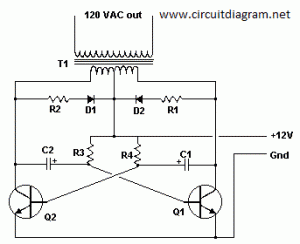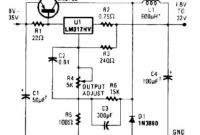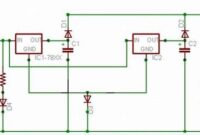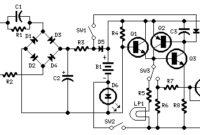The following diagram is the basic design diagram of inverter circuit. The circuit will convert 12V DC to 120V AC. This basic inverter circuit can handle up to 1000Watts supply depends the T1, T2 and transformer used. Please see the note.
Basic Inverter Components list:
| Part | Total Qty. | Description | Substitutions |
| C1, C2 | 2 | 68 uf, 25 V Tantalum Capacitor | |
| R1, R2 | 2 | 10 Ohm, 5 Watt Resistor | |
| R3, R4 | 2 | 180 Ohm, 1 Watt Resistor | |
| D1, D2 | 2 | HEP 154 Silicon Diode | |
| Q1, Q2 | 2 | 2N3055 NPN Transistor (see “Notes”) | |
| T1 | 1 | 24V, Center Tapped Transformer (see “Notes”) | |
| MISC | 1 | Wire, Case, Receptical (For Output) |
Notes:
1. Q1 and Q2, as well as T1, determine how much wattage the inverter can supply. With Q1,Q2=2N3055 and T1= 15 A, the inverter can supply about 300 watts. Larger transformers and more powerful transistors can be substituted for T1, Q1 and Q2 for more power.
2. The easiest and least expensive way to get a large T1 is to re-wind an old microwave transformer. These transformers are rated at about 1KW and are perfect. Go to a local TV repair shop and dig through the dumpster until you get the largest microwave you can find. The bigger the microwave the bigger transformer. Remove the transformer, being careful not to touch the large high voltage capacitor that might still be charged. If you want, you can test the transformer, but they are usually still good. Now, remove the old 2000 V secondary, being careful not to damage the primary. Leave the primary in tact. Now, wind on 12 turns of wire, twist a loop (center tap), and wind on 12 more turns. The guage of the wire will depend on how much current you plan to have the transformer supply. Enamel covered magnet wire works great for this. Now secure the windings with tape. Thats all there is to it. Remember to use high current transistors for Q1 and Q2. The 2N3055’s in the parts list can only handle 15 amps each.
3. Remember, when operating at high wattages, this circuit draws huge amounts of current. Don’t let your battery go dead :-).
4. Since this basic inverter project produces 120 VAC, you must include a fuse and build the project in a case.
5. You must use tantalum capacitors for C1 and C2. Regular electrolytics will overheat and explode. And yes, 68uF is the correct value. There are no substitutions.
6. This circuit can be tricky to get going. Differences in transformers, transistors, parts substitutions or anything else not on this page may cause it to not function.





I want to start a blog that everyone will read. After all, my opinions are extremely important. How do I get started?.
Dear sir
please also give its operation &how it works
Dear sir
I want to make 12v dc to 240v ac,500 watts inverter.plz send the message which requirements i need and send me circuits and parts name in my mail address.
d component is incomplete but correct diagram no center tape
desparetly in need of a 24/48 v DC to 2.5KVA AC inverter circuit, please am eloka at h3lokar@yahoo.com
please i need a 2.5KVA DC to AC inverter circuit, {h3lokar@yahoo.com }get back to me is urgent please
the first and secon digit are th denom’s and the third is the # 0’s ,,,well I have some .068’s and some .047’s now what? and what about those taht have “4700-K and “J percentage of accur”written on them are they 4700uf, nf or what the ****!
these code’s, surely the brains that come up with this stuff can write out THE CODES
“Harry “Lanthall ?” Harry’s circuit’s uses the same M/V circuit 3055’s without the Cap’s. and Though I haven’t built it either,,NO CENTER TAPP at present he has a vidieo on youtube too and it works,,,,,,comments anyone?
this same circuit is posted on youtube under “crazzigs” site and the C’s are 47uf tant’s he got the circuit from somewhere else,, anyone owant to comment?
What is the code for the 68uf? anyone care too anserw?
I wonder how many of you are like me and get sick of trying too gather the parts for these NEAT-O circuits, finding a local supplier like R.Shack used to be that actually had anything on hand only to find you have too,,,ORDER IT!! I started years ago gathering all discarded elect’s to scrap out and save. BUT FOR THE LIFE OF ME,,why don’t these sites start putting the “PRINTED” codes for the ceram’s Tant that you can hardly read on the part so we don’t have to spend time calculating the code and hoping WE got it right!! Thats if you can find a calculator like “ELECTRONICS 2000” that has one. Half the time I give up searching and blow the whole mess off my bench while waiting for the Post Office to deliver (1 or 2) parts! On this circuit, out of ALL the parts I have collected and shelved in my 40×30 shop, I have mangaged to find 0ne 68uf ceramic,,,,at least I believe thats what I have, ONE!! will a pair of 47uf’s do the JOB?
want 5000volt from car battery suggest me urgent!!!!!!!!!!!!!!!!!!!
i want to generate 220volts with this same circuit. can you help me with how am to go about it. is urgent!!
68uF (C1 and C2) together with (R3 and R4) is to determine the frequency. It should be valid value. Tantalum capacitor (and metal film resistor) is a must to get the right wave frequency.
i want to know if upgrading the device will permit the change of the 25V/68uF? if you are on line right now then please reply me quick. am waiting
i really appreciate people like you at least for bringing out your time to to post these circuit
and their diagrams. could you please send me a 12v dc 240ac inverter circuit diagram ?,
Regard
Hey there can any one help me out….i want to make a 4.5v DC to 4.5v AC inverter circuit….can any one help me with the circuit diagram…
Dear Sir
I have tested my project, but it is giving same output as per input, and my transsfer is getting heatedup. I tried with it 6 volt charing battery.
Pl. inform to me to make corrective action in this regard.
Thank you
Of course if you want to add a battery, it must be connected paralel. Series connection will doubled the voltage while paralel connection will doubled the electric current.